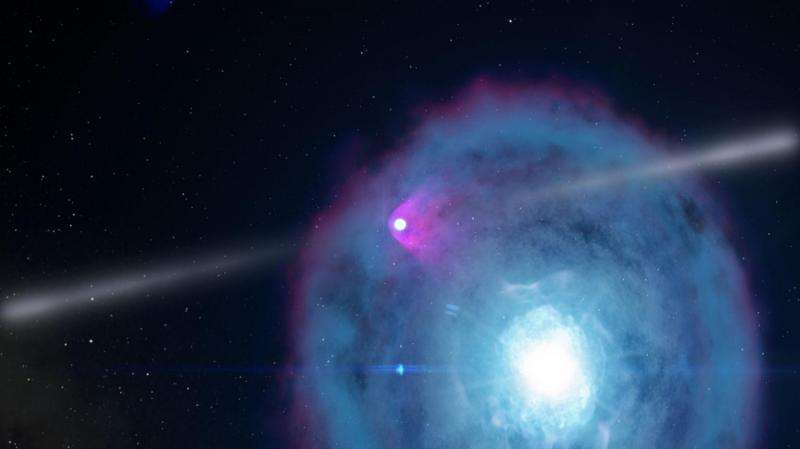Astronomers predict fireworks from a close encounter of the stellar kind

Astronomers are predicting a close encounter between a stellar remnant the size of a city and one of the brightest stars in the Milky Way.
The small object, a pulsar, was initially discovered by NASA's Fermi Gamma-ray Space Telescope. Dedicated follow-up radio observations led by a team at The University of Manchester's Jodrell Bank Centre for Astrophysics, using the 76-m Lovell Radio Telescope, now show that the pulsar travels in an extreme orbit around a companion star. This orbit will, in early 2018, plunge the pulsar through a broad disk of gas and dust round its partner, generating a spectacular series of explosions which will create a range of emissions from radio waves to gamma rays. Scientists are planning a global campaign to watch the event, which could reveal important information about the formation of stars.
The pulsar, known as PSR J2032+4127, is a highly magnetized neutron star weighing nearly twice as much as the Sun. It spins 7 times a second, but is only about 20 kilometres across. Following its discovery by Fermi in 2009, precision timing of its radio flashes indicates that it is falling rapidly under the gravitational pull of a massive young star known as MT91 213. The orbit derived from these observations has a period of about 25 years and shows that the pulsar will pass very close to the star in less than 3 years time.
MT91 213, a stellar type known as a Be star, is fifteen times the mass of the Sun and shines 10,000 times brighter. Be stars are characterized by strong outflows, called stellar winds, and large encircling disks of material. As the pulsar speeds around this inferno, astronomers will be able to use it as a probe to measure the star's gravity, magnetic field, the density of the wind flowing from the star and the structure of its disk.
Professor Andrew Lyne of The University of Manchester is lead author of a paper on the phenomenon, which has been published in the journal Monthly Notices of the Royal Astronomical Society. He said: "This is the longest-period binary system known to contain a radio pulsar and provides an excellent opportunity to study these massive stars, important progenitors for supernovae and sources of many of the heavy elements in the Galaxy."
Dr Paul Ray of the Naval Research Laboratories, Washington, added: "When we discovered this pulsar in 2009, we noticed that it was in the same direction as this massive star in the constellation Cygnus, but our initial measurements did not give any evidence that either star was a member of a binary system. The only way to escape that conclusion was if the binary system had a very long orbital period, much longer than the longest known pulsar-massive star binary at the time, which seemed unlikely."
It was only the long-term dedicated timing campaign at Jodrell Bank that revealed the true binary nature of the system. It seems that the system just barely escaped being thrown apart in the violence of the supernova explosion that created the pulsar and placed it in this very long and eccentric orbit.
There are half a dozen other such systems with companion stars that are burning hydrogen, but none are apparently as extreme in mass, orbital period or proximity to the Earth as PSR J2032+4127. Two of these are also known pulsar/Be-star systems and contain the pulsars B1259-63 and J1638-4725. High-energy observations of B1259-63 during a recent pass by its companion SS 2883 revealed intense flashes of high-energy gamma-ray and X-ray radiation as the pulsar dived through the star's disk. Similar high-energy radiation is likely during J2032+4127's pass by MT91 213 and this event will offer an exciting opportunity to investigate close-up the properties of such a rare and extreme system.
Professor Ben Stappers of Manchester University said: "This forewarning of the energetic fireworks expected at closest approach in three years' time allows us to prepare to study the system across the entire electromagnetic spectrum with the largest telescopes."
After the close encounter, the pulsar's speed will then carry it away from the star whose gravity will eventually drag it back for another roasting a quarter of a century later.
More information: "The binary nature of PSR J2032+4127." MNRAS (July 21, 2015) Vol. 451 581-587 DOI: 10.1093/mnras/stv236 First published online June 16, 2015. arxiv.org/abs/1502.01465
Journal information: Monthly Notices of the Royal Astronomical Society
Provided by University of Manchester




















